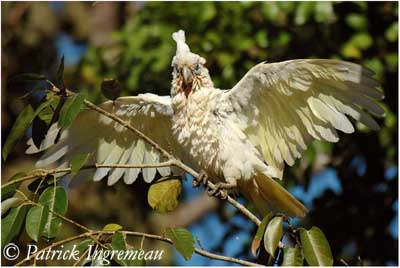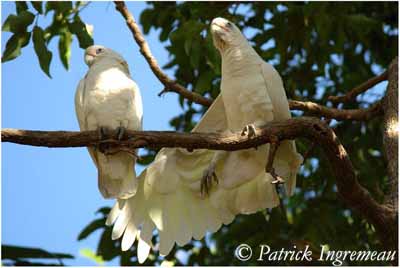
Little Corella or Little Cockatoo
Cacatua sanguinea
Psittaciforme Order – Cacatuidae Family
BIOMETRICS:
Length: 36 à 40 cm
Weight: 430 à 580 g
DESCRIPTION:
Little Corella is a white Australian cockatoo.
Adult has white or greyish-white plumage on upperparts, depending of the light.
Underparts are white too, but we can see bright sulphur-yellow on underwings and undertail when in flight. Sometimes, feathers may have pinkish-orange tinge to their bases.
On the white head, we can see a conspicuous blue bare eye-ring, and eyes are dark brown. Lores are pinkish. Bill is pale blue-grey to whitish, with short, blunt upper mandible. Legs and feet are dark grey.
The crown and forecrown feathers are longer and may erect and form a small short crest.
Both sexes are similar.
Juvenile resembles adults, but it has shorter bill, and orbital area is less blue.
Fr: Cacatoès corella
All : Nacktaugenkakadu
Esp : Cacatúa Sanguínea
Ital : Piccola corella
Nd : Naaktoogkaketoe
Photographs by Patrick Ingremeau
TAMANDUA
Text by Nicole Bouglouan
Sources:
HANDBOOK OF THE BIRDS OF THE WORLD volume 4 by Josep del Hoyo, Andrew Elliot and Jordi Sargatal – LYNX EDICION – ISBN 8487334229
PARROTS OF THE WORLD – An Identification Guide – by Joseph M. Forshaw – Princeton University Press – ISBN 0691092516
Wikipedia (Wikipedia, The Free Encyclopedia)
Birds in backyards (Birds Australia and Australian Museum)

We can find two other Australian species, very similar in plumage:
The Long-billed Corella (Cacatua tenuirostris) differs by an orange-scarlet band across the throat.
The Western Corella (Cacatua pastinator) has larger white crest.
There are five subspecies:
C.s. sanguinea, with bare eye-ring dark grey-blue, more extensive beneath eye.
C.s. normantoni, is smaller in size.
C.s. transfreta, with underwings and undertail suffused brownish yellow.
C.s. gymnopis, with more extensive pink-orange on lores and on feathers’ bases of head, foreneck, upper breast and hindneck.
C.s. westralensis, has bright orange-red lores and bases of feathers, also on mantle and lower underparts.

VOICE: SOUNDS BY XENO-CANTO
Little Corella utters chuckling trisyllabic “curr-ur-rup…curr-ur-rup…curr-ur-rup” ending in upwards inflexion, and often given when in flight. It gives harsh shrieks when disturbed.
HABITAT:
Little Corella is common in open woodlands, as in coastal or semiarid to arid regions, mangroves, and tree-lined streams in dry interior. Feral populations are found in urban areas.

RANGE:
Little Corella is found in southern New Guinea, and western, northern, and inland-eastern Australia, mainly below 400m of elevation. It has been introduced in Tasmania.
BEHAVIOUR:
Little Corella often congregates in croplands or grazing areas. It moves out to feed in open scrublands, but often feeds in large noisy flocks.

These cockatoos feed mainly on the ground, searching for grains and grass seeds. They also eat bulbs and fruits. Increase of agriculture has also increased populations of these birds, and they may become pests for these areas. When feeding in great numbers, the entire flock moves along in the same direction.
Little Corella is resident and usually, only non breeding birds perform local movements.
It feeds from dawn to midday, and then, in late afternoon. Between these two moments, it rests in nearby trees. It returns to roost at dusk, performing some acrobatics before settling for the night.

The trees where they perch for the night are often destroyed little by little, because Little Corella chews the bark of small branches.
They are sociable birds, often seen in pairs or in small flocks.

FLIGHT:
Little Corella flies with rapid, flapping wing beats, interspersed with short glides with down curved wings. It is a strong flier, able of travelling long distances.
REPRODUCTION:
Little Corella may breed at any time in good conditions. Pair bonds are for entire life. Breeding usually starts at the beginning of a long rain period.

Nest is situated in tree hollow, and it is lined with shavings of wood. Nest is usually reused during several years. This species nests in large colonies, with several nests in the same tree. It also nests in cavities in cliffs and termite mounds.

Female lays 2 to 4 white eggs. Incubation lasts about 25 days, shared by both adults. Altricial chicks are totally dependent on adults.
Young fledge about 55 days after hatching. After fledging, family groups join large nomadic foraging flocks.
Young reach their sexual maturity between 4-5 and 6-7 years.


DIET:
Little Corella feeds mainly on fruits, grains, seeds of grass and bulbs, but it also takes small insects.
PROTECTION / THREATS / STATUS:
Little Corella may become pests when they feed in large flocks in cultivated areas. They also damage the trees where they roost because they chew the bark. They also are very noisy when in groups, creating disturbances in local tourist industry.
Little Corella is widely distributed in arid Australia and numbers seem to have increased.
Little Corella is listed as an unprotected species. Landholders are entitled to shoot birds, and discourage formation of large destructive flocks.